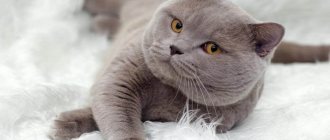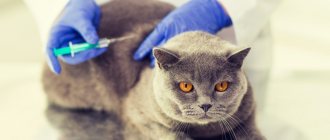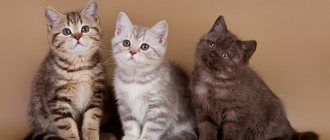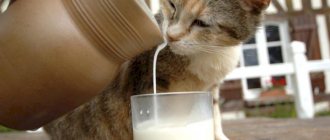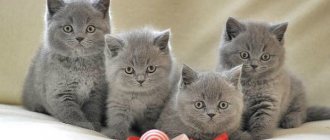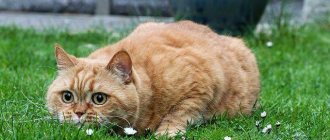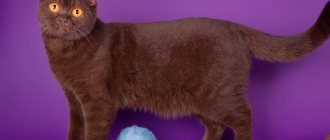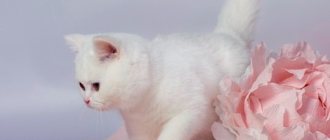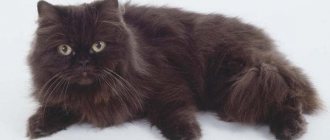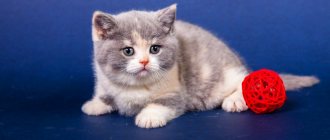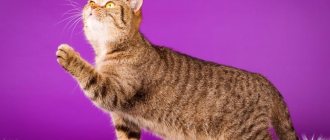The British cat is very popular all over the world. She attracts with her sweet and at the same time majestic appearance. The fur of British cats is plush and soft to the touch. There are two types of British cats: British Shorthair and British Longhair. In the article we will talk about the characteristics of this breed, the history of its origin, care and maintenance.
British cat: description of the breed
Description of the breed
The British breed cat is a medium-sized animal with an athletic build and short limbs. The pet's head is round in shape, and its muzzle is slightly smoothed. A distinctive feature of their appearance is considered to be fluffy and thick cheeks, as well as slight folds on the skin of the abdomen and neck. Eye color can be amber-yellow, but blue and emerald shades are allowed as standard. Tail length is medium.
Representatives of the breed are characterized by a wayward character and can be touchy. Their cleanliness is emphasized by their high intelligence and grace. The British and Scottish breeds should not be confused. You can distinguish a British cat from a Scottish one not only by its character, but also by its external features.
Origin story
There are several versions and information about the origin of the British cat breed. Scientists are of the opinion that it was bred in the distant past. The official date of appearance of the breed is 43 AD. In those days, Emperor Claudius decided to strengthen his throne by sending 4 legions of his soldiers to the British Isles. But it soon turned out that they did not come there themselves, but with several pets. By chance, the animals quickly adapted to the new climatic conditions and began to breed in Britain.
For 40 years, there were confrontations between the Romans and the Celts, and the animals gradually won the hearts of the English inhabitants with their appearance and behavior.
At the end of the 19th century, residents of the British Isles awarded the breed the title of national.
Accepted Standards
Clean cats of the British breed should have the correct head shape with an expanded skull. The muzzle is also round, and adults have slightly full cheeks, which make them “smiling.”
The pet's nose is short, straight and wide. If you look at the purr from the side, there will be a slight depression where the nose meets the forehead.
The ears are set low but set wide apart. At the same time, the eyes are quite large and open, with a golden tint. The standard mentions that owners of the point color have blue eyes. The presence of a bright green and even lavender hue cannot be ruled out.
But some breeders consider dull color or the presence of a rim near the pupil to be a defect.
Other breed deficiencies may include:
- Excessive secretion of mucous membranes.
- “Exoticness” of the muzzle. If there is a pronounced transition from the forehead to a hump, the muzzle loses its aesthetic appeal. In addition to the deformation of the nose, the proportionality of the eyes and cheekbones deteriorates.
- The shape of the muzzle is often identical to that of barn cats. This is emphasized by a flat forehead, large brow ridges and a long nose.
Over the years of living on the British island, the animals developed a strong immune system and became the owners of a strong, muscular body of medium or large size. Pets are characterized by a wide torso and a massive back, as well as strong but short legs. The length of the tail is considered short, but with a thickened diameter.
All existing subspecies of the British breed are distinguished by pronounced sexual demorphism. Externally, cats are much smaller than cats, especially when it comes to adults. Animals are able to quickly gain weight, while their maturation occurs at a slow pace. The kitten grows up to four years old, and the last stage of development of appearance is completed upon reaching the age of 5 years. Over a five-year period of time, a pet gains about 5-8 kg, and a cat weighs 4-6 kg. The average lifespan of British cats reaches 15 years.
The coat has different lengths, which are determined by the breed line. According to the standard, any characteristics of wool are allowed, with the exception of length. The following color types are not yet permitted:
- White.
- Color point.
As for short-haired pets, their coat is 2.4 mm long.
Those with long hair are characterized by an aristocratic character. Mixing them with other cat breeds is strictly prohibited.
If there is a monochromatic color, a balanced coloring of each hair is provided, so any third-party shades are excluded. The breed standard does not allow haze, shimmer or shade.
There are about 30 color options for British breed cats. And animals with black, blue, cream, red, lilac and white fur have special decorative value.
The best two-tone colors are blue-silver, tabby, ticked and merle.
Today, cats with the “Whiskas” coloring are in particular demand. They took part in the filming of the famous advertisement. The official name of the color is “mackerel”. The characteristic combination of shades is due to three wide stripes in the back area.
Due to the “plushness” of the coat, owners of some colors do not look graceful enough. These include individuals with chocolate fur (cinnamon).
Getting offspring
Sexual maturity in representatives of the British Shorthair breed occurs at approximately 7–9 months, but it is better to cross a female cat with a male at the age of 10 months to one and a half years. It was during this period that her physical condition allows her to bear and give birth to offspring without harm to her health. Mating should be carried out when the third heat occurs.
How to choose the best partner for a cat
For mating, it is necessary to select a cat similar in color to the female cat. The offspring of animals with contrasting colors can turn out to be multi-colored. This will not affect the health of the kittens, but animals with a single-colored skin are considered more valuable. It is better to choose an experienced “groom” who has already participated in mating more than once.
Kittens of a classic blue color, like any solid color, are considered more valuable
Rules and features of mating
The first time after the meeting, the cat may not let the cat near. This is normal, there is no need to force her. When the female shows desire, up to 15 matings can occur per day. After two days, the “groom” loses interest, because by this time the female’s smell changes. Usually this period is enough for the cat to become pregnant.
The beginning of pregnancy is considered to be the second day of the female’s stay with the “groom”. If, after 3 weeks, heat occurs, then the “date” should be arranged again. It is not recommended to breed cats more than three times a year. This will weaken the animal and lead to the appearance of sick offspring.
British cat character
When considering interesting facts about British cats, one cannot ignore their mannerisms. In simple words, these animals are considered the main connoisseurs of personal space who will not tolerate interference from third parties. This character has been formed over many centuries. And even external cuteness does not prevent these creatures from remaining wayward, proud and self-confident. The lack of connection between the inner and outer world is best demonstrated in the behavior of animals.
The name “British” perfectly characterizes the style of these cats. And if some breeders consider them to be kind, social and friendly creatures, others claim that pets do not tolerate familiarity, but prefer an independent lifestyle.
When living together with other pets or people, cats do not show capriciousness, but provided that the neighbors do not claim their personal comfort zone. However, you cannot buy them as a gift for a child, because... an adult cat will not play with a small family member. Unlike other cat breeds, British cats are not afraid of loneliness. Therefore, people leading an active lifestyle, who rarely stay at home for a long time, can confidently give preference to such pets.
British diseases
These cats are distinguished by excellent health and are considered a fairly hardy breed. But at the same time, there are diseases to which they are susceptible. This breed has two types of blood at once - A and B, which can cause problems if you decide to start breeding cats.
British Shorthair cats have about 36% type B blood. If they mate with type A cats, a litter of both types A and B may result. Kittens with type A blood are relatively healthy individuals, but die within 24 - 72 hours, which is called “disappearing kitten syndrome” and is explained by the presence of B antibodies, which are produced against type A. Antibodies can pass to the kitten with mother’s milk, where they fight the baby’s red blood cells and kill them.
Using a special DNA test, you can determine what type of blood a kitten has and avoid their death. Other diseases include: dental problems, tendency to be overweight, infectious diseases. The latter can be prevented by timely vaccination of the animal.
It is necessary to vaccinate the animal and give anthelmintic drugs in accordance with the schedule in order to avoid infection with various infectious diseases and parasites. The British by nature have excellent health and resistance to disease, but preventive procedures and regular examination by a veterinarian once a year are the minimum that every loving owner should do for their pet.
Features of care and maintenance
Unlike many elite cat breeds, British pets do not require complex and meticulous care. Being unpretentious creatures, they get along freely in a city apartment and develop normally if basic living conditions are provided.
One of the most important rules of care is to remove the short undercoat at intervals of 7 days. To perform this procedure, use a soft rubber brush, which eliminates the possibility of the formation of static electricity. During the molting period, the coat is combed every day. Otherwise, traces of undercoat will be present on all the furniture in the house.
Caring for a British shorthair cat requires the use of special pharmaceutical products that prevent hair from clogging the stomach. Such medications are sold in the form of tablets and food products that dissolve hairballs in the gastrointestinal tract.
When caring for your pet, you need to monitor the condition of its claws, preventing the appearance of fungi, chips or cracks. If you do not have the skills to trim yourself, it is better to take your pet to a veterinary clinic.
Nutrition specifics are based on the following products:
- Meat. In order for a cat to develop normally, look healthy and beautiful, it needs to be given a large amount of meat products. Their share in the daily diet is 3 quarters of the entire menu. Pets can be given beef or poultry, as well as offal. However, it is not allowed to use a whole piece of meat as food, because this will lead to heaviness in the stomach. To prevent this, the product must first be minced or cut with a knife.
- Garnish. ¼ of the menu is occupied by porridge, vegetables and potatoes. The British can be given a simple side dish from the table, but can cook the food separately.
- Once every 7-5 days, add a chicken egg to the diet.
- Less commonly, animals are allowed foods such as cottage cheese, kefir and cheese. It is allowed to use dry food for British cats from stores, but only high-quality food that contains the necessary vitamins and microelements.
Prohibited foods include:
- Milk. Representatives of the breed are characterized by an allergy to lactose. The product is strictly prohibited during pregnancy.
- Sweet and flour products. Experts do not recommend giving your cat treats, even as a reward for good behavior. Otherwise, pets will begin to gain excess weight and lose their decorative appearance.
- Pickled and salted vegetables. Any marinade consists of acid, which negatively affects the cat’s body. At the same time, salt prevents the free exit of fluid from the body.
- Alcoholic drinks or coffee. They impair the functioning of the cardiovascular system, causing a number of heart diseases.
First meeting
Like most similar babies, including Maine Coon kittens , before your arrival the little British were with their mother and brothers and sisters, they were accustomed to such an environment.
Once in your house, they find themselves in conditions that are alien to them, so at first they will be afraid of everything.
If your baby is hiding in a corner, do not try to force him out of there.
The article https://kot-pes.com/kak-poymat-kota-v-lovushku/ will tell you how to catch a cat in a trap.
If you really don’t like the place he has chosen, be smart and lure the cat out with a toy; in the excitement the kitty will forget about stress.
A British kitten carefully studies a parrot to understand whether to be friends with it or hunt it
Immediately show your British baby his food and water bowls, his sleeping place and his litter tray, which has not only been filled with fresh litter, but also a handful of what was in his old potty.
Do not let the kitten walk around the entire apartment on the first day. Firstly, there is a possibility that he will get lost and again, out of fear, will hide in another corner.
Secondly, the kitty may not reach the tray and relieve itself on the way to it.
After a few days, when the new family member has completely settled in, you can open the doors of all rooms for him.
However, the gray-blue color of British kittens sometimes allows them to blend into the carpet, so watch your step carefully.
British kittens know how to properly care for indoor plants
Health
Purebred British dogs are characterized by resistance to common diseases and strong immunity. They are not afraid to sleep on the windowsill with the window open, walk freely in frosty or rainy weather and endure any vagaries of the climate characteristic of England.
But some diseases still appear. Among them is gingivitis. Initially, an inflammatory process is noticed in one tooth, but as it progresses, it affects the remaining teeth. With extended periodontitis, tissue connections separate, resulting in the disease affecting the roots of the teeth.
The next common pathology is hypertrophic cardiomyopathy. It is manifested by the following symptoms:
- Anorexia.
- Lack of appetite.
- Decreased heart rate per minute.
- Breathing problems, wheezing and coughing.
- Sudden loss of limb mobility.
- The appearance of a bluish tint on the paw pads.
To prevent such a disease, it is better to regularly examine the kitten with ultrasound. If he does not show symptoms of the pathology until the age of eight, in the future the risk of its development will be reduced to a minimum.
The British are also susceptible to hemophilia. The problem is characterized by intense bleeding during minor injuries or surgery.
Diseases of British cats include claw fungus. It manifests itself in the form of spots on the claws or their deformation. To protect animals from the problem, it is necessary to constantly monitor the condition of the limbs.
Vaccination is a prerequisite for care. Having important vaccinations reduces the risk of developing panleukopenia, calcivirus, rabies and chlamydia.
The vaccine is administered from 2-3 months of age or at 8 months of age, when the pet has completed the period of changing teeth.
Initially, the cat is given medicine for worms, and if the parasites were not removed and reappeared after 10 days, it is necessary to carry out repeated deworming. And only after 2 weeks is vaccination allowed.
If there are no worms in the stool, vaccination is performed in the basic mode. But after each regular vaccination, a two-week quarantine must be maintained.
Preparation
The preparation includes several stages:
1. Explain to children how to properly handle a British baby.
It must be made clear that a kitten is not a toy that can be constantly carried in your arms, dragged by its tail or paws, and so on.
Children should learn that the British Blue kitten needs to be left undisturbed when he goes into his house, eats, or goes to the toilet .
2. Solve organizational issues: where the cat will eat, go to the toilet and sleep.
At first glance it seems that this is not so difficult. However, cats in general, and the British in particular, are conservative animals.
You can learn how to make a cat bed with your own hands from the article
In matters such as the location of familiar places, they do not like change.
Therefore, the selected corners should be assigned to the animal, if possible, for its entire life. There should be a scratching post .
Mrr, I haven’t done any mischief here yet
3. Purchase the necessary items for the cat. This includes:
- tray, also known as toilet;
- filler , at least it will be necessary at first;
- cat house - you can make it yourself, then you need to take care of suitable materials;
- a carrier, it will also come in handy when the baby grows up to transport the animal, for example, to the veterinarian or to the country;
- toys, like a house, you can make them yourself, which means we care about the safety of materials;
Stylish house for a British cat
- bowls for water and food; You don’t have to buy something special, but use durable ceramic bowls, but it is important that their inner side is completely smooth, without cavities into which food can get stuck and mold there;
- nail clipper;
- cotton buds;
- shampoo for short-haired cats;
- repellent spray – just in case, to prevent bad habits from developing, we’ll talk about them in more detail later.
This article will tell you how to properly make a house for a cat with your own hands.
Breeding
For decades, breeders have crossed purebred British cats with Scots, but today it is the purity of both varieties that is of particular value. And in some countries the combination of breeds is prohibited by law.
The first estrus begins in cats at five months of age. However, at this time you cannot breed them with cats, because... the body has not yet gone through all the stages of its formation.
Experts recommend choosing a partner for the British breed in a timely manner and agreeing with the owners to meet the male and female cats a couple of days after the heat. It is advisable to leave the cat in the male's house for a while. In this case, the animals will find a connection faster, and the cat will feel more confident in its territory.
If there is no desire to breed offspring, the cat is spayed and the male cat is neutered.
Buying a pet is a responsible decision that requires preliminary preparation. It consists of providing favorable living conditions and purchasing all accessories and things for the cat.
And if a British breed is purchased, its owner must remember to follow the basic rules of cat care. When buying a small animal, you need to take into account all the little things, even the most insignificant ones.
In this case, the growth and development of the pet will occur without problems or deviations.
Raising a kitten
When thinking about purchasing a kitten of this breed, you need to first ask yourself the question not about how much a kitten costs, but about where you should buy a kitten so that it is healthy and can bring joy with its existence for a long time. When a cute live teddy bear - a British kitten - appears in the house, a person’s life changes greatly. All British kittens are cute, playful and active. You can see them sedate and calm when they are closer to one year of age.
